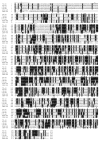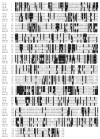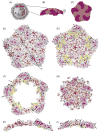Conserved structure/function of the orthoreovirus major core proteins
- PMID: 19720241
- PMCID: PMC5123878
- DOI: 10.1016/j.virusres.2009.03.020
Conserved structure/function of the orthoreovirus major core proteins
Abstract
Orthoreoviruses are infectious agents with genomes of 10 segments of double-stranded RNA. Detailed molecular information is available for all 10 segments of several mammalian orthoreoviruses, and for most segments of several avian orthoreoviruses (ARV). We, and others, have reported sequences of the L2, all S-class, and all M-class genome segments of two different avian reoviruses, strains ARV138 and ARV176. We here determined L1 and L3 genome segment nucleotide sequences for both strains to complete full genome characterization of this orthoreovirus subgroup. ARV L1 segments were 3958 nucleotides long and encode lambda A major core shell proteins of 1293 residues. L3 segments were 3907 nucleotides long and encode lambda C core turret proteins of 1285 residues. These newly determined ARV segments were aligned with all currently available homologous mammalian reovirus (MRV) and aquareovirus (AqRV) genome segments. Identical and conserved amino acid residues amongst these diverse groups were mapped into known mammalian reovirus lambda 1 core shell and lambda 2 core turret proteins to predict conserved structure/function domains. Most identical and conserved residues were located near predicted catalytic domains in the lambda-class guanylyltransferase, and forming patches that traverse the lambda-class core shell, which may contribute to the unusual RNA transcription processes in this group of viruses.
Conflict of interest statement
The authors declare no competing interests.
Figures







Similar articles
-
Avian reovirus L2 genome segment sequences and predicted structure/function of the encoded RNA-dependent RNA polymerase protein.Virol J. 2008 Dec 17;5:153. doi: 10.1186/1743-422X-5-153. Virol J. 2008. PMID: 19091125 Free PMC article.
-
Sequences of avian reovirus M1, M2 and M3 genes and predicted structure/function of the encoded mu proteins.Virus Res. 2006 Mar;116(1-2):45-57. doi: 10.1016/j.virusres.2005.08.014. Epub 2005 Nov 16. Virus Res. 2006. PMID: 16297481 Free PMC article.
-
Extensive sequence divergence and phylogenetic relationships between the fusogenic and nonfusogenic orthoreoviruses: a species proposal.Virology. 1999 Aug 1;260(2):316-28. doi: 10.1006/viro.1999.9832. Virology. 1999. PMID: 10417266
-
Orthoreovirus and Aquareovirus core proteins: conserved enzymatic surfaces, but not protein-protein interfaces.Virus Res. 2004 Apr;101(1):15-28. doi: 10.1016/j.virusres.2003.12.003. Virus Res. 2004. PMID: 15010214 Review.
-
[Orthoreoviruses].Uirusu. 2014;64(2):191-202. doi: 10.2222/jsv.64.191. Uirusu. 2014. PMID: 26437841 Review. Japanese.
Cited by
-
Detection and Characterization of a Reassortant Mammalian Orthoreovirus Isolated from Bats in Xinjiang, China.Viruses. 2022 Aug 27;14(9):1897. doi: 10.3390/v14091897. Viruses. 2022. PMID: 36146702 Free PMC article.
-
Reovirus Core Proteins λ1 and σ2 Promote Stability of Disassembly Intermediates and Influence Early Replication Events.J Virol. 2020 Aug 17;94(17):e00491-20. doi: 10.1128/JVI.00491-20. Print 2020 Aug 17. J Virol. 2020. PMID: 32581098 Free PMC article.
-
Sequence analysis of the genome of piscine orthoreovirus (PRV) associated with heart and skeletal muscle inflammation (HSMI) in Atlantic salmon (Salmo salar).PLoS One. 2013 Jul 29;8(7):e70075. doi: 10.1371/journal.pone.0070075. Print 2013. PLoS One. 2013. PMID: 23922911 Free PMC article.
-
Molecular and Antigenic Characterization of Piscine orthoreovirus (PRV) from Rainbow Trout (Oncorhynchus mykiss).Viruses. 2018 Apr 2;10(4):170. doi: 10.3390/v10040170. Viruses. 2018. PMID: 29614838 Free PMC article.
-
The VP2 protein of grass carp reovirus (GCRV) expressed in a baculovirus exhibits RNA polymerase activity.Virol Sin. 2014 Apr;29(2):86-93. doi: 10.1007/s12250-014-3366-5. Epub 2014 Mar 4. Virol Sin. 2014. PMID: 24643934 Free PMC article.
References
-
- Bartlett JA, Joklik WK. The sequence of the reovirus serotype 3 L3 genome segment which encodes the major core protein lambda 1. Virology. 1988;167:31–37. - PubMed
-
- Benavente J, Martinez-Costas J. Avian reovirus: structure and biology. Virus Res. 2007;123:105–119. - PubMed
-
- Bisaillon M, Bergeron J, Lemay G. Characterization of the nucleoside triphosphate phosphohydrolase and helicase activities of the reovirus lambda1 protein. J Biol Chem. 1997;272:18298–18303. - PubMed
-
- Bodelon G, Labrada L, Martinez-Costas J, Benavente J. The avian reovirus genome segment S1 is a functionally tricistronic gene that expresses one structural and two nonstructural proteins in infected cells. Virology. 2001;290:181–191. - PubMed
Publication types
MeSH terms
Substances
Associated data
- Actions
- Actions
- Actions
- Actions
Grants and funding
LinkOut - more resources
Full Text Sources

